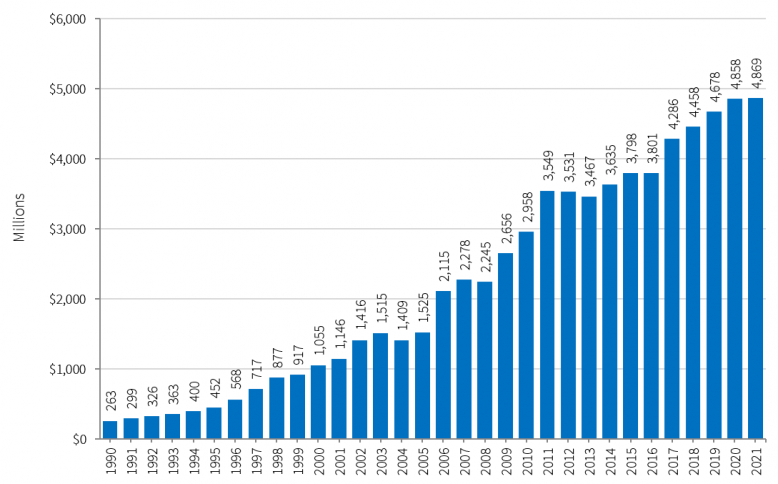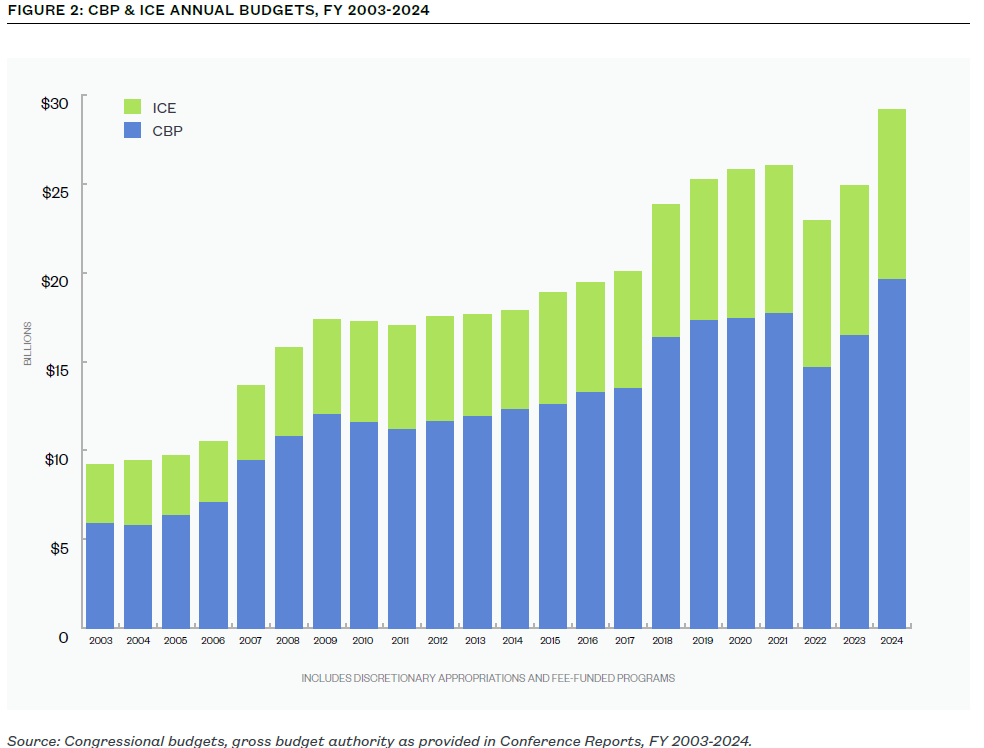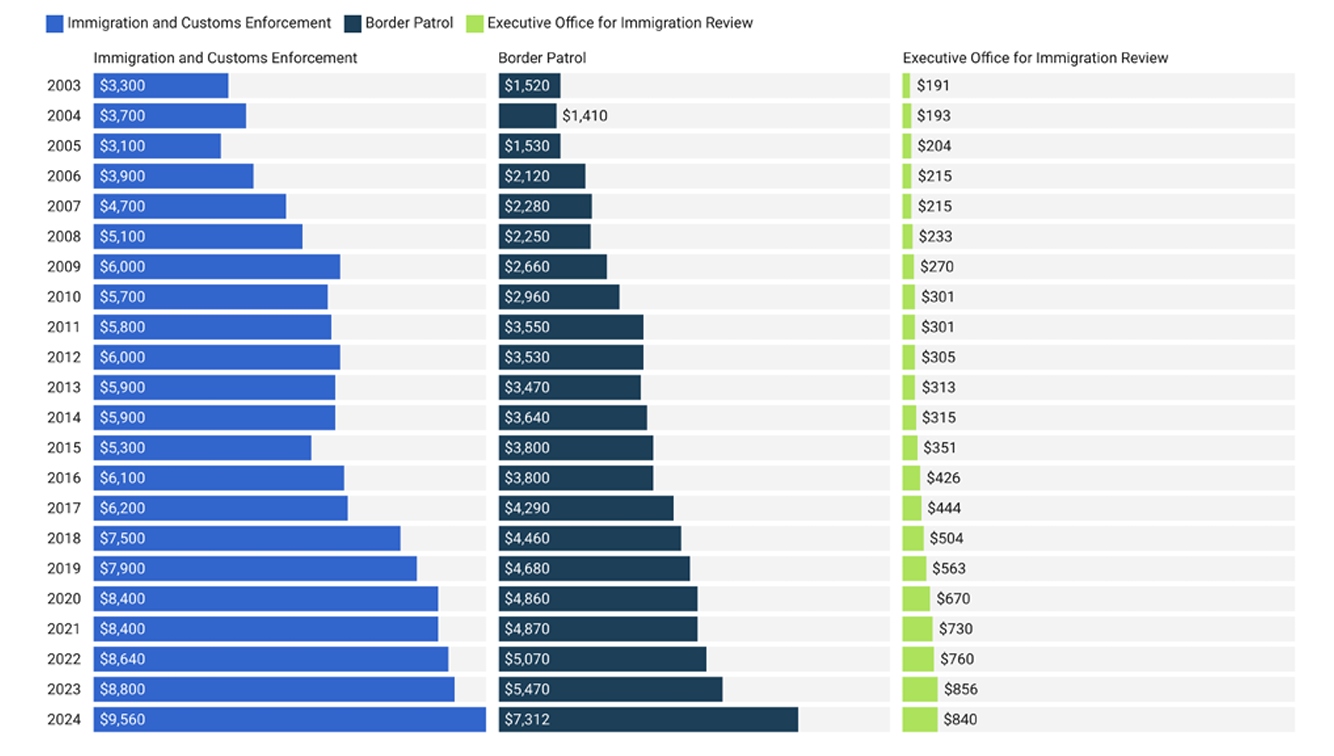- Fact Sheet
The Cost of Immigration Enforcement and Border Security
Published
Since the creation of the Department of Homeland Security (DHS) in 2003, the federal government has spent an estimated $409 billion on the agencies that carry out immigration enforcement, and tens of billions more on border barriers and other immigration enforcement-related infrastructure projects. As Congress continues to increase enforcement-related funding to new record highs, it is important to review how much money has already been spent on these initiatives, and what outcomes have been produced.
Immigration enforcement spending largely falls into two issue areas: border security and interior enforcement. Border spending includes staffing and resources needed for U.S. Customs and Border Protection (CBP), an agency of DHS working at and between United States ports of entry. Interior enforcement is primarily focused on staffing and resources for U.S. Immigration and Customs Enforcement (ICE), also part of DHS, to apprehend noncitizens in the interior of the country, detain or monitor those undergoing removal proceedings, and deport those ordered removed.
Currently, ICE and CBP employ nearly 88,000 people in total. The number of U.S. Border Patrol agents nearly doubled from 10,717 in Fiscal Year (FY) 2003 to 19,357 FY 2022. Additionally, the number of people working at ICE’s Enforcement and Removal Operations (ERO) nearly tripled from FY 2003 to FY 2024. In FY 2024, ICE was funded to employ 7,711 staff at ERO.
In February 2019, after the longest government shutdown in history of 35 days, Congress reached a deal with President Trump offering $1.375 billion for 55 miles of fencing along the Rio Grande Valley. The President expressed his dissatisfaction with this offer, and shortly after signing the bill, he declared a national emergency to fund his border wall through alternative means. In total, President Trump spent roughly $15 billion on border barriers during his four years in office.
What has this spending bought? The United States currently has roughly 735 miles of fencing along the Southern border, record levels of staff for ICE and CBP, as well as a fleet of drones¾ among other resources. Some of these resources have been spent on ill-conceived projects such as the $1 billion attempt to construct a “virtual fence” along the Southwest border - a project initiated in 2005 that was later scrapped for being ineffective and too costly. CBP announced a similar project in July 2020 to install a total of 200 “autonomous surveillance towers” along remote areas of the southern border at a reported cost of several hundred million dollars.
Even with record level spending on enforcement, enforcement alone is not sufficient to address the challenges irregular migration brings. It also has significant unintended consequences; according to U.S. Border Patrol statistics, the Southwest border witnessed more than two deaths per day in FY 2022. Deaths have only increased since then reaching record levels in FY 2023 and 2024. All of these efforts that have accumulated in the name of security, however, do not necessarily measure border security properly, or secure the border.
Critically, increases in funding for immigration enforcement have significantly outpaced funding for the United States humanitarian protection and adjudication systems. In FY 2024, Congress provided $3.43 billion to immigration detention centers alone. By contrast, Congress appropriated just $840 million for the entire immigration court system, and funded $424 million to the entirety of U.S. Citizenship and Immigration Services’ refugee and asylum division. In other words, the United States spent nearly three times as much on immigration detention alone than it did on the entire adjudication system for removal and asylum claims. This consequently—leads to skyrocketing case backlogs and years of delay.
It is past time for the United States to turn away from strictly focusing on enforcement and deterrence-based policies and instead focus on a more balanced approach that provides the resources necessary to build a functional humanitarian protection system while balancing security interests.
The Cost of Immigration Enforcement and Border Security in Dollars
The immigration enforcement budget has increased massively since the early 1990s, but many members of Congress and the president continue to call for more taxpayer dollars to be spent on immigration enforcement.
- Since 1994, when the current strategy of concentrated border enforcement was first rolled out along the U.S.-Mexico border, the annual budget of the U.S. Border Patrol has increased nearly 20-fold, rising from $400 million to over $7.3 billion in FY 2024 (Figure 1). Even when adjusted for inflation, that is an increase of over 765 percent.
Figure 1: U.S. Border Patrol Budget, FY 1990-2021

Sources: See endnote 14.
- Since the creation of DHS in 2003, ICE spending has nearly tripled from $3.3 billion to $9.6 billion in FY 2024 (Figure 2). Much of this funding has gone to increasing the agency’s ability to hold immigrants in detention around the country, to electronically monitor noncitizens on “alternatives to detention”, and to carry out deportations.
- Since 2003, the budget of CBP, which includes both the Border Patrol and operations at ports of entry, has also more than tripled, rising from $5.9 billion in FY 2003 to a high of $19.6 billion in FY 2024 (Figure 2). When adjusted for inflation, that is an increase of 144 percent.
Figure 2: CBP & ICE Annual Budgets, FY 2003-2024

Previous Benchmarks Have Been Met, Yet Enforcement Funding Continues to Grow
The federal government has already met the border security benchmarks laid down in earlier Senate immigration reform bills.
- As the American Immigration Lawyers Association pointed out in a January 2013 analysis, the “benchmarks” for border security specified in the bipartisan 2006, 2007, and 2010 immigration-reform legislative packages in the Senate have been largely met. Yet each time a benchmark was met, Congress continued to fund ever-greater levels of enforcement without significant increases in adjudication or passage of broader reforms to the immigration system.
- The requirements in those Senate bills for more border enforcement personnel, border fencing, surveillance technology, unmanned aerial vehicles, and detention beds have also been fulfilled and in many ways surpassed. ICE detention bed funding reached a record level in FY 2024, funding 41,500 beds, the third highest level in Congressional history. And when Congress authorizes ICE to increase detention beds, the agency often detains more than funded. For example, despite Congress appropriating enough money for 40,520 beds throughout the year, ICE’s use of budgetary mechanisms in FY 2019 to shift money from other locations to their detention account led to ICE breaking records by detaining more than 55,000 people.
Border security depends on the smart and efficient use of available resources. At the same, border enforcement cannot and should not be done in isolation. Instead, it must be examined in the larger context of reforms needed for the entire immigration system.
There is a Serious Enforcement-Adjudication Funding Mismatch
Despite pouring hundreds of billions of dollars into immigration enforcement over the last two decades, Congress has often failed to provide similar funding infusions to the immigration court system. Taken together, from FY 2003 through 2024, Congress has spent $24 on ICE and Border Patrol for every $1 spent on the immigration court system. Over that 22-year period, Congress spent $11.65 billion on the immigration courts (see Figure 3)—$3.5 billion less than the Trump administration spent on border walls alone.
Figure 3: Annual budgets of ICE, Border Patrol, and EOIR, in millions of dollars

Given this funding mismatch, the immigration court’s backlog of cases has risen every single year since FY 2007. As of the middle of FY 2024, there were more than 3.7 million cases pending in the immigration court system, an increase of over 2000 percent since 2007. Despite the demand, as of the first quarter of FY 2024, there were only 725 immigration judges across the entire country for an average of nearly 5,000 cases per judge. So long as Congress continues to supercharge enforcement at the expense of adjudication, these backlogs will likely persist, and the funding poured into enforcement will not produce the results intended.
Since the creation of the Department of Homeland Security (DHS) in 2003, the federal government has spent an estimated $409 billion on the agencies that carry out immigration enforcement and tens of billions more on border barriers and other immigration enforcement-related infrastructure projects. As Congress continues to increase enforcement-related funding to new record highs, it is important to review how much money has already been spent on these initiatives, and what outcomes have been produced.
Immigration enforcement spending largely falls into two issue areas: border security and interior enforcement. Border spending includes staffing and resources needed for U.S. Customs and Border Protection (CBP), an agency of DHS working at and between United States ports of entry. Interior enforcement is primarily focused on staffing and resources for U.S. Immigration and Customs Enforcement (ICE), also part of DHS, to apprehend noncitizens in the interior of the country, detain or monitor those undergoing removal proceedings, and deport those ordered removed.
Currently, ICE and CBP employ nearly 88,000 people in total. The number of U.S. Border Patrol agents nearly doubled from 10,717 in Fiscal Year (FY) 2003 to 19,357 FY 2022. Additionally, the number of people working at ICE’s Enforcement and Removal Operations (ERO) nearly tripled from FY 2003 to FY 2024. In FY 2024, ICE was funded to employ 7,711 staff at ERO.
In February 2019, after the longest government shutdown in history of 35 days, Congress reached a deal with President Trump offering $1.375 billion for 55 miles of fencing along the Rio Grande Valley. The President expressed his dissatisfaction with this offer, and shortly after signing the bill, he declared a national emergency to fund his border wall through alternative means. In total, President Trump spent roughly $15 billion on border barriers during his four years in office.
What has this spending bought? The United States currently has roughly 735 miles of fencing along the Southern border, record levels of staff for ICE and CBP, as well as a fleet of drones¾ among other resources. Some of these resources have been spent on ill-conceived projects such as the $1 billion attempt to construct a “virtual fence” along the Southwest border - a project initiated in 2005 that was later scrapped for being ineffective and too costly. CBP announced a similar project in July 2020 to install a total of 200 “autonomous surveillance towers” along remote areas of the southern border at a reported cost of several hundred million dollars.
Even with record level spending on enforcement, enforcement alone is not sufficient to address the challenges irregular migration brings. It also has significant unintended consequences; according to U.S. Border Patrol statistics, the Southwest border witnessed more than two deaths per day in FY 2022. Deaths have only increased since then reaching record levels in FY 2023 and 2024. All of these efforts that have accumulated in the name of security, however, do not necessarily measure border security properly, or secure the border.
Critically, increases in funding for immigration enforcement have significantly outpaced funding for the United States humanitarian protection and adjudication systems. In FY 2024, Congress provided $3.43 billion to immigration detention centers alone. By contrast, Congress appropriated just $840 million for the entire immigration court system, and funded $424 million to the entirety of U.S. Citizenship and Immigration Services’ refugee and asylum division. In other words, the United States spent nearly three times as much on immigration detention alone than it did on the entire adjudication system for removal and asylum claims. This consequently—leads to skyrocketing case backlogs and years of delay.
It is past time for the United States to turn away from strictly focusing on enforcement and deterrence-based policies and instead focus on a more balanced approach that provides the resources necessary to build a functional humanitarian protection system while balancing security interests.
Help us fight for immigration justice!
The research is clear – immigrants are more likely to win their cases with a lawyer by their side. But very few can get attorneys.
Introducing the Immigration Justice Campaign Access Fund.
Your support sends attorneys, provides interpreters, and delivers justice.

Immigration Justice Campaign is an initiative of American Immigration Council and American Immigration Lawyers Association. The mission is to increase free legal services for immigrants navigating our complicated immigration system and leverage the voices and experiences of those most directly impacted by our country’s immigration policies to inform legal and advocacy strategies. We bring together a broad network of volunteers who provide legal assistance and advocate for due process for immigrants with a humane approach that includes universal legal representation and other community-based support for individuals during their immigration cases.

